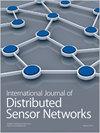Deep learning–based resource allocation for secure transmission in a non-orthogonal multiple access network
IF 2.5
4区 计算机科学
Q3 COMPUTER SCIENCE, INFORMATION SYSTEMS
International Journal of Distributed Sensor Networks
Pub Date : 2022-06-01
DOI:10.1177/15501329221104330
引用次数: 1
Abstract
Machine learning techniques, especially deep learning algorithms have been widely utilized to deal with different kinds of research problems in wireless communications. In this article, we investigate the secrecy rate maximization problem in a non-orthogonal multiple access network based on deep learning approach. In this non-orthogonal multiple access network, the base station intends to transmit two integrated information: a confidential information to user 1 (the strong user) and a broadcast information to user 1 and user 2. In addition, there exists an eavesdropper that intends to decode the confidential information due to the broadcast nature of radio waves. Hence, we formulate the optimization problem as a secrecy rate maximization problem. We first solve this problem by employing convex optimization technique, then we generate the training, validation, and test dataset. We propose a deep neural network–based approach to learn to optimize the resource allocations. The advantages of the proposed deep neural network are the capabilities to achieve low complexity and latency resource allocations. Simulation results are provided to show that the proposed deep neural network approach is capable of reaching near-optimal secrecy rate performance with significantly reduced computational time, when compared with the benchmark conventional approach.基于深度学习的非正交多址网络安全传输资源分配
机器学习技术,特别是深度学习算法已被广泛应用于无线通信领域的各种研究问题。在本文中,我们研究了基于深度学习方法的非正交多址网络中的保密率最大化问题。在这种非正交多址网络中,基站打算向用户1(强用户)传输机密信息和向用户1和用户2传输广播信息两种综合信息。此外,由于无线电波的广播性质,存在意图解码机密信息的窃听者。因此,我们将优化问题表述为保密率最大化问题。我们首先采用凸优化技术来解决这个问题,然后生成训练、验证和测试数据集。我们提出了一种基于深度神经网络的方法来学习优化资源分配。所提出的深度神经网络的优点是能够实现低复杂度和延迟的资源分配。仿真结果表明,与基准的传统方法相比,所提出的深度神经网络方法能够在显著减少计算时间的同时达到接近最优的保密率性能。
本文章由计算机程序翻译,如有差异,请以英文原文为准。
求助全文
约1分钟内获得全文
求助全文
来源期刊
CiteScore
6.50
自引率
4.30%
发文量
94
审稿时长
3.6 months
期刊介绍:
International Journal of Distributed Sensor Networks (IJDSN) is a JCR ranked, peer-reviewed, open access journal that focuses on applied research and applications of sensor networks. The goal of this journal is to provide a forum for the publication of important research contributions in developing high performance computing solutions to problems arising from the complexities of these sensor network systems. Articles highlight advances in uses of sensor network systems for solving computational tasks in manufacturing, engineering and environmental systems.

 求助内容:
求助内容: 应助结果提醒方式:
应助结果提醒方式:


